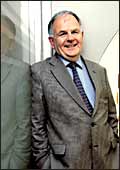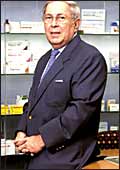 |
 |
| The MNCs of Indian pharma:
Ranbaxy's Brian Tempest (left) and Sun Pharma's Dilip Sanghvi |
 |
 |
| The global Indians: Cipla's
Y.K. Hamied (left) and Dr Reddy's MD & COO Satish Reddy |
At the end of
a long working day, Malvinder Mohan Singh, though tired, is looking
happy. The President of the Rs 5,426-crore Ranbaxy Laboratories
had arrived earlier that morning from the us after a week-long
trip. Despite a long flight, his eyes straining from lack of sleep,
Singh had driven straight to his office in Gurgaon's Sector 32.
The 33-year-old scion of India's largest pharmaceutical company
has been fielding calls from journalists and business partners
the entire day. But for a change, Singh has some positive news
to share. The previous day, on November 9, Ranbaxy had won a process
patent challenge in Norway against Pfizer's anti-cholesterol drug
Lipitor. Although the Scandinavian nation is a small, $50-million
(Rs 225-crore)-a-year market (and growing at 8-10 per cent) for
Lipitor, it's a big morale booster for Ranbaxy, as it received
an adverse judgment in a UK court early last month (of course,
Ranbaxy plans to appeal against the UK court's decision soon).
But the Norway ruling (although partial, as Pfizer has won its
defence on the patent of the intermediate compound) is a confidence-enhancer
since the mother of all judgments is expected in December-when
a us court will announce its verdict on the Lipitor challenge
for that market. The value of the anti-cholesterol drug in the
US market is $7 billion (Rs 31,500 crore), which is as big as
India's domestic pharma industry. Singh says, "We are very
confident of winning our challenges. We have a strong case."
Funnily enough, whichever way the decision
goes, either party has the right to appeal against it. Besides,
challenging Big Pharma's innovations can become time-consuming,
costlier and uncertain. Ranbaxy has already spent $30 million
(Rs 135 crore) in legal fees this year and the amount is unlikely
to come down next year since the number of blockbuster drugs it
has been challenging has gone up from 11 last year to 17 or 18
currently. Nevertheless, that's one of the paths India's frontline
pharma companies like Ranbaxy and Dr Reddy's (DRL) have chosen
to further their growth. In the past, Ranbaxy and DRL have won
such patent challenges and raked in huge revenues (for instance,
Ranbaxy's Cefuroxime Axetil launch in March 2002 raked in $115
million-Rs 563.5 crore then-in just nine months). "It's a
high-risk-high-return strategy. If you can crack one drug like
Lipitor (valued at $11 billion or Rs 49,500 crore), it will bring
in previouly unheard of revenues to the company," says an
analyst.
| Five Things Going For The Sector |
| »
India's low-cost chemistry skills are an advantage.
The country has the potential to capture a significant share
of the $30 billion (Rs 1,35,000 crore) worth global contract
research industry.
»
India is emerging as a hub for clinical trials. A dozen
global companies such as AstraZeneca, Bayer, Eli Lilly,
GlaxoSmithKline, Novartis and Pfizer have chosen India as
a centre for conducting clinical trials and research.
»
In India it will cost only about $100-200 million (Rs 450-900
crore) to develop a new drug, compared to the US' $500-900
million (Rs 2,250-4,050 crore), so a lot of basic research
is expected to be shifted to the country.
»
$80-billion (Rs 3,60,000 crore) worth of drugs are going
off patent globally in the next three to five years, and
India stands to gain with its innovative and branded generics.
»
Indian companies have shown that they are capable of acquiring
companies abroad and will continue to do that to expand
geographies and product portfolio.
|
But coping up with uncertainties in patent
challenges is only one part of the worry for the Indian pharma
biggies. The other is the cyclical nature of the US generics market,
resulting in huge price erosions in the bread-and-butter generics
business of Indian pharma leaders. For instance, Ranbaxy saw a
huge 90 per cent dip in its net profits in the third quarter (ended
September 30, 2005) to Rs 18.7 crore from Rs 200.4 crore in 2004.
In fact, the company has been putting up a poor show on the revenue
as well as profit fronts for the last few quarters. Much of this
can be ascribed to spiralling R&D costs, a spike in marketing
expenses, and of course, because of lower sales realisations in
the US market. The result: investor sentiment took a beating,
with the Ranbaxy stock hitting a 52-week low of Rs 344 on October
25, eroding almost 60 per cent of its market cap in a matter of
few days.
| Five Things That Could Go Wrong |
| »
MNCs will have an advantage over the next 10
years in the domestic pharma market. The product patent regime
is already here, which disallows copying drugs patented after
January 1, 1995.
»
Highly commoditised generics industry would put pressure
on topline, so Indian companies will have to cut costs and
streamline their product portfolio, while at the same time
enhancing their marketing budget.
»
There is a growing consolidation in the international generics
market (for instance, Teva acquired Ivax). Indian biggies
too will have to go for size.
»
If the product pipeline is not continuously spruced up with
a steady stream of ANDA and Para IV filings, it would affect
future earnings.
»
The smaller companies (estimates range from 5,000-25,000
such) could vanish if they don't improve manufacturing practices
and standards.
|
DRL had also faced a similar situation last
year. In February 2004, it lost a legal battle to launch its specialty
drug amlodipine maleate (a variant of amlodipine besylate, the
essence of Pfizer's best-selling angina and hypertension drug
Norvasc), dashing its hopes of tapping a $200-million (Rs 900-crore)-a-year
opportunity; besides, the company was losing share in the generics
market in the us. Then Novo Nordisk announced that it was discontinuing
trials of an insulin sensitiser molecule, which was licensed to
it by DRL. The result of all the bad news was that DRL's stock
tanked to Rs 700-half its peak price in early 2004. However, that's
changing as the company is taking a host of steps to drive revenues
and cut costs (more on that later).
So which are the most valuable pharma companies
in this year's BT 500? It is a mixed bag. For instance, Ranbaxy
and DRL, which have a similar strategy of strong R&D focus
and the expensive policy of challenging patents, are significant
losers. Ranbaxy, ranked 9 in 2004, is down to 11 this year. DRL
tanked to 42 from 25 last year. One can see a similarity in what
DRL went through last year and what Ranbaxy is going through currently.
On the other hand, Sun Pharmaceuticals (which maintained the rank
of 24) and Cipla (up to 23 from 25 last year), who do not follow
the high-risk strategy of Ranbaxy and DRL, have benefitted.
| Bottomline Saver |
 |
| Ranbaxy R&D: Not keen on partnership
yet |
Three
weeks after Dr Reddy's Laboratories (DRL) floated Perlecan
Pharma in a unique deal with Citigroup Venture Capital and
ICICI Venture, the company's Executive Vice President and
Chief Financial Officer Vishar Subramanian Vasudevan gets
a reward: a promotion to President and Chief Finance Officer.
In a mail to employees, DRL Executive Vice Chairman and CEO
G.V. Prasad talked of the innovative deals 'Vasu' had spearheaded.
Besides giving shape to Perlecan, the country's first integrated
drug development company to undertake research on new chemical
entities (NCEs), Vasu was also instrumental in striking a
deal with ICICI Venture to fund generics research early this
year. These are clearly innovations in finance. And DRL needed
them since heavy R&D spending had been taking its toll
on the company, which was already been suffering from declining
margins in the US market. "Perlecan provides a model
to rapidly advance DRL's existing as well as future NCE assets
through Phase-II trials and seek out-licensing, co-development
or joint commercialisation opportunities," says Vasudevan.
So, is DRL setting an example for others in the industry
who have been grappling with the cyclical fluctuations in
the commoditised generics market or those who do not want
to take on research risks all by themselves? Gujarat-based
Torrent Pharmaceuticals is believed to be thinking of roping
in a private equity or venture capital firm to share its
R&D risks. The partnership will be aimed at guiding
one of its lead molecules through the process of advanced
development to a stage of clinical application. Taking the
lead compounds to clinical trial stage involves studies
on a global scale and is fraught with high costs and uncertainties.
But not every pharma exec will concur with that. "It's
a good model for anybody who has a bottom line problem,"
says the chairman of a leading pharma company. Ranbaxy Laboratories,
despite a slip in its bottom line in the last few quarters,
says it will not consider any such partnerships currently.
"Partnerships have always been available. But we haven't
felt the need yet," says Malvinder Singh, President
(Pharmaceuticals). Then, at the end of the day, sharing
risks mean sharing returns too.
|
What have helped Sun are its strong domestic
business and its lower dependence on the price-sensitive American
generics market (exports constitute only 40 per cent of Sun's
sales while they do 80 per cent of Ranbaxy's). In generics, Sun
is maintaining a tight leash over costs. Says Dilip Sanghvi, Chairman,
Sun Pharmaceuticals, "Ultimately, the generics business is
all about costs." In Cipla's case, although domestic sales
have remained flat, its core business of exporting formulations
is doing well, and is growing at 15 per cent quarter-on-quarter.
Cipla has also successfully struck partnerships with large us-based
generic companies such as Watson, Ivax and Pentech Pharma for
supplying formulations. Says Shahina Mukadam, Head (Research),
IDBI Capital, "Cipla's model is low risk. It partners with
litigators instead of litigating itself."
 |
| DRL's dose: Can you see the big bucks? |
But DRL and Ranbaxy hope to turn around their
fortunes through innovative deals, spruced-up product portfolios
and smart acquisitions. In March this year, DRL struck a landmark
deal with private equity firm ICICI Venture to raise $56 million
(Rs 252 crore), which will fund the cost of launching generics
in the US market. Last month, in a deal that was first of its
kind in Indian pharma, DRL teamed up with Citigroup Venture Capital
and ICICI Venture to form Perlecan Pharma, which will fund the
development of new chemical entities. The private equity investors
will each put in $22.5 million (Rs 101.25 crore) in Perlecan while
DRL will contribute $7.5 million (Rs 33.75 crore), and over time
hold a majority stake of close to 75 per cent in the company.
And on November 9, it acquired Roche's Active Pharmaceutical Ingredients
business, in Mexico for $59 million (Rs 265.5 crore), helping
it emerge a leading player in the Custom Pharmaceutical Services
(cps) business and position itself as a partner of choice for
innovator companies.
DRL's Executive VC and CEO G.V. Prasad says,
"We have not altered the trajectory for the company, but
we do recognise the shareholders' concerns in the short term."
| FAQ |
| Are the companies in a sector where India
has a long-term competitive advantage?
Low-cost manufacturing, world-class talent and well-developed
R&D skills put the Indian pharma sector on par with
that of the developed markets.
Do the companies have what it takes to succeed in the
long-term?
The sector has companies that have been in the business
for the last 40 to 70 years (like Ranbaxy and Cipla) and
have successfully transformed in tandem with changing market
dynamics.
Should you invest in the companies (sector)?
You should, depending on your risk appetite and investment
horizon. The four companies that we have discussed are good
medium- to long-term bets, and there are several others
too that are worthy picks.
|
Ranbaxy is also affected badly by the short-term
investor expectations, which Singh says "has no basis".
"Any upside from a win in the Lipitor challenge has not been
factored into Ranbaxy's future earnings while expenses have been
factored in the costs." So a temporary legal setback has
no impact on the fundamentals of the company. Concurs Y.K. Hamied,
Chairman, Cipla, "I am against quarterly, half-yearly, or
even annual performance expectations. We are in the business of
science." But the price erosion in the US generics market
is real and the key is how the companies are planning to tackle
it. "In the case of Ranbaxy," says Brian Tempest, CEO,
"the strategy is three-pronged-cut costs, have a strong product
portfolio and explore inorganic opportunities." Ranbaxy has
already got 111 products approved by the US Food and Drug Administration
and 43 are awaiting approval, which will be the key to tap $40
billion (Rs 1,80,000 crore) worth of drugs going off patent in
the next three years. Besides, the company plans to raise $1.5
billion (Rs 6,750 crore) through a combination of instruments
like ADRs, GDRs and FCCBs, and another $1.5 billion through debt.
"This will be used to acquire quality assets in the us (or
anywhere else)." DRL, which hived off its R&D risks to
separate entities with the help of private equity investors, claims
a pipeline of 50 ANDAS pending for approval. Among them, 26 are
Para IV opportunities that give a 180-day exclusivity in marketing.
Indian pharma is clearly a mixed bag. The
frontliners like Ranbaxy and DRL, who have bet big on R&D
and risky patent challenges, are the long-term stories. Then there
is Sun and Cipla who have less risky models with a healthy combination
of domestic and export opportunities, followed by dozens of contract
manufacturers like Dishman Pharma. Take your pick.
|









